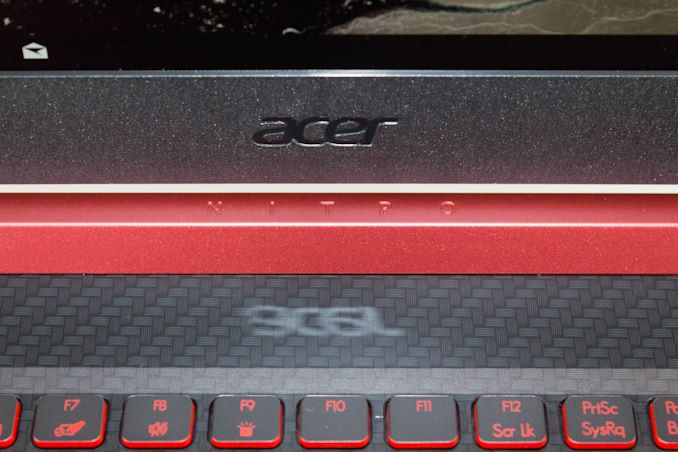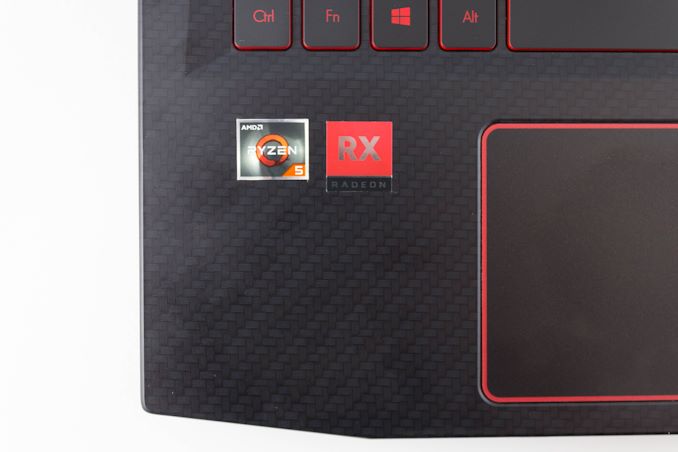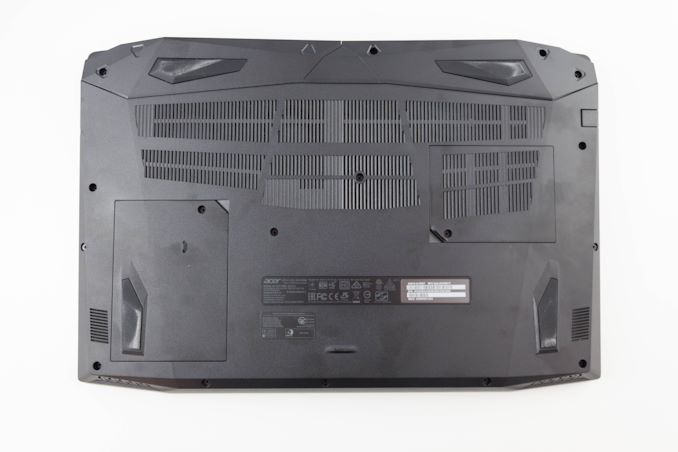The Acer Nitro 5 Gaming Laptop Review: Absolutely AMD - Ryzen Plus Polaris
by Brett Howse on February 15, 2019 8:30 AM ESTFinal Words
AMD’s Ryzen launch has transformed the company, and really brought proper competition to the CPU space that we’ve not seen in the x86 world for a long time. But Ryzen was first and foremost a desktop competitor, and even though AMD did eventually release a laptop version, it’s not had the same success as its desktop counterpart. The biggest issue is the idle power draw, which is quite high, rendering it less than ideal in an Ultrabook. However the Acer Nitro 5 is not an Ultrabook, but rather a gaming laptop, where the expectations are different and portability is closer to a desktop replacement than a laptop that needs to run off a battery all day long.
Being coupled with an AMD GPU makes the Acer Nitro 5 even more unique. The laptop world has been dominated by NVIDIA's products, so it’s rare to find laptops with AMD GPUs, and even more rare for them to be paired with an AMD CPU. It’s great to see this as an option again, and as we’ve seen, the laptop is competitive as well.
Although the shell of the Nitro 5 is completely plastic, Acer has done a nice job with the styling, and the faux carbon fibre adds some texture and character to a laptop which would otherwise be just flat black plastic. The laptop is plenty strong as well.
There’s also a great cooling system inside, and it never has to work too hard to keep the thermals in check. The CPU didn’t even reach 70°C, and the GPU was only 71°C after a full hour of gaming, and during that hour the sound level only peaked at about 46 dB(A), which is well under some larger gaming laptops. Acer also offers a CoolBoost setting if you want extra cooling, but from what we observed, there’s little reason to ever turn that on. Even better, at idle and light workloads, the laptop is completely silent, since it’s now got a big gaming cooling system to only deal with a U series Ryzen processor.
In terms of performance, the Nitro 5 does very well, especially when you look at the price. It offers far more performance than any Ultrabook, Ryzen equipped or not, and the RX 560X in terms of pure GPU performance can go toe to toe with the GTX 1050. On the CPU side, the Ryzen 5 2500U can’t quite match the 45-Watt Intel quad-cores, but the performance is still quite good.
Clearly Acer had to cut some items to reach their price point, and the display was one of those areas, but even though it can’t do 100% of the sRGB gamut, and even though it’s likely the least accurate IPS display we have ever tested, at the end of the day it is still a 1920x1080 IPS panel, offering good viewing angles, and a good resolution for a gaming laptop of this performance level. Really the only valid criticism of the display on a device like this is that it doesn’t support 1600x900 or 1366x768, both of which would be valuable resolutions for full-screen gaming. With just 1920x1080 or 1280x720 as available 16:9 options, there’s a big jump there in resolution which might be the difference between unplayable and playable.
Even with the shortcomings, the Acer Nitro 5 is still a great value. The AMD powered model is even more so. At $669.99 as a starting price, it’s well under most Ultrabooks in terms of cost, yet delivers far more performance. And with the 256GB SSD model running just another $30, it’s a much better 15.6-inch laptop than many you see on the market with 1366x768 displays and 500 GB spinning drives. If you are after a gaming laptop and you’re on a budget, definitely check this model out.














90 Comments
View All Comments
RSAUser - Friday, February 15, 2019 - link
Did you try and use the wattman auto undervolt for the graphics card?Does Radeon Chill work for mobile? Then fan noise should go down and battery should last longer.
Testing max fps is bad, don't even have minimum fps, let alone frame time plots to know how smooth it is.
jgraham11 - Friday, February 15, 2019 - link
Wow, did anyone notice that all the other processors are 45Watt meanwhile the AMD chip is only 15W!!! Holy crap!PeachNCream - Friday, February 15, 2019 - link
How can you miss that fact? The differences in TDP were pointed out multiple times in the article. You'd have to be in some serious skim mode to overlook it.cfenton - Saturday, February 16, 2019 - link
From the article: "Being a U series, the TDP is 15-Watts by default, though AMD offers a range of cTDP modes from 12-25 Watts. This is a rarely tapped feature on most laptops, but in this case it looks like Acer has put the Ryzen in cTDP up mode."So the AMD chip is 25w and the Intels are using 35w. It's a difference for sure, but it's not 15w vs 45w.
Brett Howse - Saturday, February 16, 2019 - link
The Intel ones are 45W - the 35W is an optional cTDP down mode.cfenton - Saturday, February 16, 2019 - link
My mistake. Thanks for the clarification.jgraham11 - Saturday, February 16, 2019 - link
For sure I believe you are correct, except for the MSI one which is 45watt.One thing I did find while looking at these specs for these Laptops:
Note all Newegg.com prices except the Acer AMD setup, as I could not find it. Prices are as of Feb 16 2019.
MSI GT75 TITAN GTX 1080 8 GB VRAM i9-8950HK sells for $4958.64
Huawei MateBook X Pro Intel Core i7 8th Gen 8550U MX150 sells for $1449.00
Dell XPS 15 core I7-7700HQ GTX 1050 sells for $1849.55
Microsoft Surface Book 2 Core i7 8650U GTX 1050 sells for $2279.00
This is not an Apples to Apples comparison in the least!
Meanwhile they are comparing it to a $699 AMD laptop....
Do you think that the extra $1k would provide a metal chassis which would result in better overall thermals hence better performance. And a better screen...
Anandtech please compare this one to another Acer Nitro 5 but with an Intel processor to actually make it a fair comparison.
Brett Howse - Saturday, February 16, 2019 - link
I explained why the comparison models were chosen in the review.fmcjw - Sunday, February 17, 2019 - link
Really? You don't take suggestions really well do you? I second jgraham11's suggestion because the thermal design makes each Intel Core a different beast.This is really an amateurish review, you can get as much info from a compact notebookcheck.com analysis. Who needs to be told that "Being a SATA based SSD, peak performance is certainly limited compared to NVMe drives, but it still offers orders of magnitude better performance compared to spinning drives?" Just show it in a table or chart. Are you being paid to hit a certain word count?
And you're unclear on whether adding a second RAM makes it dual channel, nor have you mentioned that you tried to see if Dual Channel is supported, but rather stuck to whatever configuration the company sent you.
Calin - Monday, February 18, 2019 - link
For spinning versus solid state hard drive performance, you have plenty of comparisons - when the transition took place, 5 or so years ago. Today's SATA SSD's aren't so much faster than the champions of 5 years ago (in typical end-user scenarios), but neither have the magnetic hard drive performance improved.